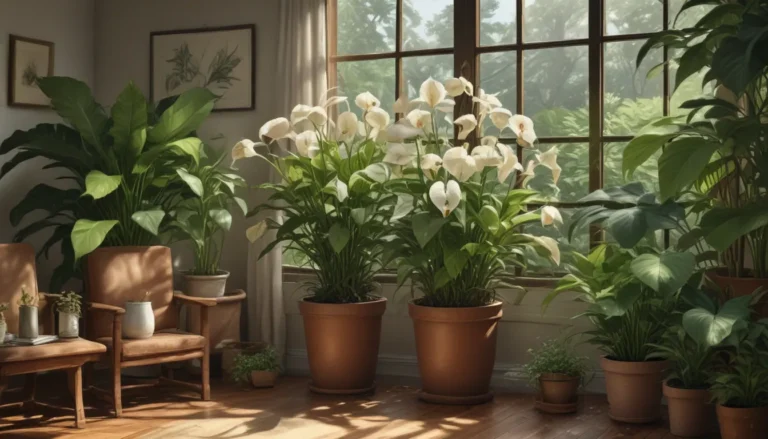The Ultimate Guide to Growing Impatiens Indoors

Are you tired of the same old houseplants and looking to add some vibrant color to your indoor spaces? Look no further than impatiens! These cheerful and colorful flowers, also known as jewelweed, busy Lizzie, patience, or touch-me-not, are a fantastic choice for indoor gardening.
In this comprehensive guide, we will cover everything you need to know about growing impatiens indoors, from propagation to maintenance, species selection, and pest management. By the end of this article, you’ll be equipped with all the information you need to successfully grow these beautiful flowers in your home or office.
So grab your gardening gloves and let’s dive in!
What You’ll Learn
Here’s a sneak peek at what you’ll discover in this guide:
- Propagation
- How to Grow
- Maintenance
- Species and Cultivars to Select
- Managing Pests and Disease
If you’re ready to add a pop of color to your indoor spaces, let’s get started!
Propagation
Impatiens can be easily propagated indoors through various methods, including seeds, cuttings, or purchased starts. Here’s a brief overview of each process:
- Propagation from seeds: Impatiens seeds require light to germinate. Simply press them into the soil, keep the soil moist, and provide bright, indirect light. Once the seeds germinate and develop true leaves, transplant them into individual containers.
- Propagation from cuttings: Take a stem with leaves and plant it in a pot filled with seed-starting mix. Keep the soil moist and provide bright, indirect light. New growth should develop within a few weeks.
- Purchased starts: You can also buy live impatiens plants and simply repot them if desired.
The good news is that you can also propagate outdoor impatiens and bring them inside without any issues.
How to Grow
Creating the ideal environment for your indoor impatiens is crucial to their success. These flowers thrive in moist, low-light conditions with moderate temperatures. Here are some key tips for growing impatiens indoors:
- Provide bright, indirect light: Impatiens do best with a bit of direct morning sun and bright, indirect light for the rest of the day. Consider placing them in front of an east-facing window or a south- or west-facing window with sheer curtains.
- Ensure proper moisture levels: Maintaining adequate soil moisture and humidity levels is essential for keeping impatiens happy indoors. Use a moisture meter to check the soil before watering.
- Feed regularly: Feed indoor impatiens with a mild, flower-specific fertilizer every two weeks during the spring and fall.
By following these tips, you can create a thriving environment for your indoor impatiens to blossom and flourish.
Maintenance
Maintaining your impatiens indoors involves regular pruning and repotting to ensure their health and longevity. Here’s how you can keep your impatiens in top shape:
- Pruning: Regularly pinch back your impatiens to prevent legginess and promote bushy growth. Additionally, prune back the stems after the flowers fade to maintain the plant’s shape.
- Repotting: If your impatiens outgrow their container, consider dividing the plant and replanting it in a larger pot or a different container.
By staying on top of pruning and repotting, you can help your impatiens thrive indoors for seasons to come.
Species and Cultivars to Select
When choosing impatiens for indoor growing, consider varieties that thrive in low-light conditions and require minimal maintenance. Here are some popular species and cultivars to consider:
- Glandulifera: Himalayan balsam is an excellent indoor option that thrives in partial sun and can be grown safely without becoming invasive.
- Parasitica: This epiphytic plant can be mounted on wood or stone indoors, adding a unique touch to your indoor space.
- Repens: Ideal for hanging baskets, this trailing species features long, red stems that add color to your room.
- Walleriani: The most common impatiens variety, Walleriani thrives in shady areas and does well indoors.
By selecting the right species and cultivars for your indoor space, you can enjoy vibrant impatiens year-round.
Managing Pests and Disease
While indoor impatiens are less prone to pests and diseases compared to outdoor plants, it’s essential to remain vigilant and practice proper plant care. Here are some tips for managing common pests and diseases:
- Aphids and spider mites: Aphids and spider mites are two major pests that can affect indoor impatiens. Use a steady stream of water to spray off the pests and repeat weekly until they are gone. Neem oil can also be used as a natural remedy.
- Impatiens Downy Mildew (IDW): This common disease can cause discoloration and defoliation of the plant. Be sure to isolate new plants and check for signs of disease before introducing them to your other plants.
By following these practices, you can protect your impatiens from common pests and diseases and ensure their continued health and vitality.
Impatiens Are Just As Nice Indoors
Impatiens are versatile and easy-to-grow plants that can bring a burst of color to your indoor spaces. Whether you choose to propagate them from seeds or cuttings or opt for purchased starts, these cheerful flowers will brighten up any room.
So why not give impatiens a try as indoor houseplants? With the right care and attention, you can enjoy their beauty and vibrancy year-round.
Which impatiens varieties will you be growing indoors? Share your thoughts in the comments section below!
For more indoor gardening inspiration, check out our guides on forcing amaryllis bulbs to bloom, growing crocuses indoors, and cultivating fuchsia as a houseplant.
Happy gardening!





